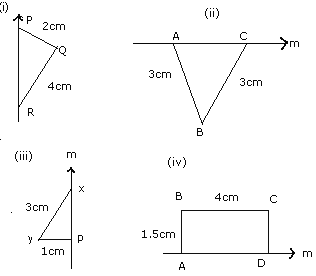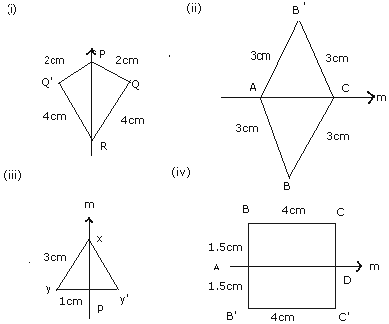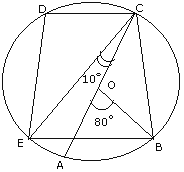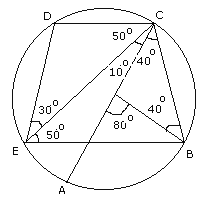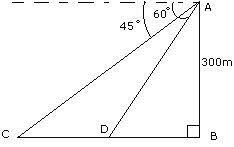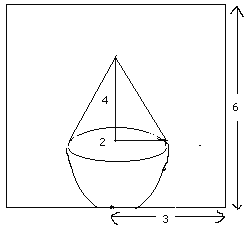ICSE Set Qa1 Year Icse Maths98 Qa1.php Mathematics Exam Paper for students online
Q6. Ruler and compasses only may be used in this question. All construction lines and arcs must be clearly shown, and be of sufficient length and clarity to permit assessment.
(i) Construct a triangle ABC, in Which BC= 6cm, AB= 9cm and angle ABC = 60o ;
(ii) Construct the locus of all points inside triangle ABC, which are equidistant from B and C.
(iii) Construct the locus of the vertices of the triangles with BC as bsase, Which are equal in area to triangle ABC.
(iv) Mark the point Q, in your construction, which would make QBC equal in area to ABC, and isosceles.
(v) Measure and record the length of CQ.
Ans. (i) Steps of construction(a) Draw a line BC = 6cm
(b) Draw –CBA
= 60o
(c) With center B & radius 9cm mark an arc cutting –
CBX at A.
(d) join AC
Hints are given.Now draw the required triangle ABC.
(ii) Draw the perpendicular bisector of BC, AC,
& AB intersecting at a point O.
Point 'O' is the required locus of all points inside triangle ABC.
(iii) Draw a circle in which AB is the diameter
& O is the mid point of AB
With center A make an angle equal to angle ABC intersecting circle at point Q.
Point Q is the locus of the vertices of the triangle.
(iv) Draw a circle in which AB is the diameter
and O is the mid point of AB.
With center A make an angle equal to angle ABC intersecting circle at point Q.
Area of triangle QBC = Area of triangle ABC & Isosceles.
(v) Measure the length of CQ from the figure.
Q7. A point P (a,b) is reflected in the X-axis to p' (2,-3). Write down the values of a and b. P" is the image of P, when reflected in the Y-axis. Write down the coordinates of P". Find the coordinates of P'", when P is reflected in the line , parallel to the Y-axis, such that x= 4.
Ans. The values of a = 2 & b=3
The coordinates of P" = (-2,-3)
When P is reflected in the line parallel to the Y-axis i.e. Y= 0
Then the coordinates of P"' = ( 2, 3)
(i)– DAB (ii)– ADB.
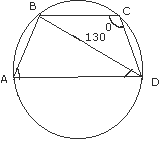
(b) State the locus of a point in a rhombus ABCD, which is equidistant
(i) From AB and AD ;
(ii) From the vertices A and C. Ans. (a)
(i)– DAB = 180o -130o
=50o
(ii)– ADB= 180o-– DAB - –ABD (angle in a semicircle is a right angle)
=40o
=180o - 50o -90o
(b) (i) Locus is point 0
(ii)Locus is point 0

SECTION-B
Q9. (a) Evaluate the following using tables:
[0.284 x ÷
(136.78)] / (4.2)2
(b) Find the value of x and y, if
| [ | 1 | 2 | ] |
[ |
x | 0 | ] | ] |
[ |
x | 0 | ] |
| 3 | 3 | 0 | y | 9 | 0 |
(c) Solve the following in equation and graph the solution set, on the number line :
2x - 3 < x + 2 < 3x + 5,x ő R
Ans (a). [0.284 x ÷(136.78)]
/ (4.2)2
=( 0.284 X 11.695 ) / 17.64 =0.188
(b)
|
[ |
1 | 2 | ] |
[ |
x | 0 | ] | = |
[ |
x | 0 | ] |
| 3 | 3 | 0 | y | 9 | 0 |
|
[ |
X | 2Y | ] | = |
[ |
X | 0 | ] |
| 3X | 3Y | 9 | 0 |
As the two matrixes are equal there elements must also be equal.
x = x , 2y = 0
3x = 9 , 3y = 0
from these we get x = 3 & y = 0
(c) 2x-3 <x+2 £ 3x+5
2x-3 <x+2 & x+2 £ 3x+5
x 2x-3-2 & 3x+5 ≥ x+2
x2x-5 & 2x ≥ -3
52x-x &-3 £ 2x
5x &-3/2 £ x
5X & -1.5 £ x
x= (-1,1,2,3,4)
Q
10. (a) If a function in x is defined by
f(x) = x /( x2+1)
and x ő
R, find :
(i)
f (1 /x), x Ļ
0
(ii) f (x-1).
(b) The center O, of a circle has the coordinates (4, 5) and one point on the circumference is (8, 10). Find the coordinates of the other end of the diameter of the circle through this point.
(c)
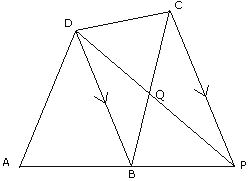
In the figure given above, ABP is a straight line. BD is parallel to PC. Prove that the quadrilateral ABCD is equal in area to triangle APD.
Ans.(a) f(x) = x /( x2 + 1 )
(i) f ( 1/x ) = [(
1 /x)] / [(1/x)2 + 1]
= (1/x) / [(1/x)2 + 1] = x
/ (1 + x2 )
(ii) f ( x - 1) = (x - 1) / [(x - 1)2
+ 1] = (x - 1) / (x2 - 2x + 2)
(b) Let P(x,y) be the coordinates of the
other end of the diameter .
According to section formula , the coordinates of P (x,y) are :-
(8+x) / 2 = 4
x= 8-8
=0
(10+y)/2 = 5
10+y =10
y= 0
Hence the coordinates of the other end of the diameter are P(0,0).
(c) Given :- Quadrilateral ABCD in which BD is parallel to PC
To Prove :- Area of triangle APD = area of Quadrilateral ABCD
Proof :- Triangle BDC & triangle BDP are on the same base DB & between same parallels DB & CP
Therefore area of triangle BDC = area of triangle BDP -------(i)
Subtracting area of triangle DBQ from both sides of equation (i)
Area of triangle BDC - Area of triangle DBQ = area of triangle BDP - area of triangle DBQ
Area of triangle DQC = area of triangle BQP -----------(ii)
Adding area of quadrilateral DABQ on both sides of equation (ii) We get
area of triangle DQC + area of quadrilateral DABQ = area of triangle BQP + area of quadrilateral DABQ
area of quadrilateral ABCD = area of triangle APD.
| Q
14(a) Only ruler and compasses may be used in this
question. All construction lines and arcs must be clearly shown and be of
sufficient length & clarity to permit assessment. (I) Construct a DABC, such that AB = AC = 7 cm. (II) Construct AD, the perpendicular bisector of BC. (III) Draw a circle with centre A and radius 3 cm. Let this circle cut AD at P. (IV) Construct another circle to touch the circle with centre A, externally at P, and pass through B and C. (b) The distance by road between two towns, A and B, is 216 km, and by rail it is 208 km. A car travels at a speed of x km/hr, and the train travels at a speed which is 16 km/hr faster than the car. Calculate : (i)
The time taken by the car to reach town B from A, in terms of x; |
|||||||||||||||||||||||||||||||||||||||||||||
| Ans.(a) (I) steps of
construction
(i) Draw a line BC=5cm (ii) With center B& radius 7cm draw an arc C (iii) With center C & taking same radius cut the previous arc at point A (iv) Join AB & AC ABC is the required triangle. Hints are given to you . You draw the required construction. (II) Steps of construction (i) With centre B & taking radius
greater than 1/2 BC mark an arc C intersecting on BC at point D (III) (Ans.) Take point A as a centre and radius = 3cm. Draw a circle cutting AD at P. (IV) (ans.) Take point D as a centre and radius = BD draw a circle passing through B & C and touching the circle with centre A, externally at P. (b) Distance by road between towns A & B = 216 km Distance by rail between towns A & B= 208 Km speed of a car = x km/hr. speed of train = (x+16) km/hr. (i) Time taken by the car = 216 / x
hr (ii) Time taken by train = 208 / (x +
16) hr (iii) ( 216/x) -(208 /x) =
2 [216(x+16) - 208x] / x (x + 16) = 2 216x +3456-208x = 2x(x+16) 8x+3456= 2x2 + 32x 2x2 + 32x-8x-3456=0 2x2+24x-3456 +0 x2+12x-1728=0 x2+48x-36x - 1728= 0 x(x+48)-36(x+48)= 0 (x+48) (x-36)= 0 x= -48 & x=36 Neglecting negative value (iv)Speed of the train = (x+16) km/hr =(36+16) km/hr =52 km/hr |
|||||||||||||||||||||||||||||||||||||||||||||
| Q 15. (a) A
solid consisting of a right circular cone, standing on a hemisphere. is
placed upright, in a right circular cylinder, full of water, and touches
the bottom. Find the volume of water left in the cylinder, having given
that the radius of the cylinder is 3 cm. and its height is 6 cm ; the
radius of the hemisphere is 2 cm. and the height of the cone is 4 cm. Give
your answer to the nearest cubic centimeter. [Take
p =
22/7] (b) Attempt this question on a graph paper. The table shows the distribution of the daily wages, earned by 160 workers in a building site.
Using a scale of 2 cm. to represent 10 Rs., and 2 cm. to represent 20 workers, plot these values, and draw a smooth ogive, through the points. Estimate from the graph - (i) The Median wage ; (ii) The upper and lower quartile wage earned by the workers. |
|||||||||||||||||||||||||||||||||||||||||||||
| Ans. (a)
Volume of a cone = 1/3 p r2 h Volume of water left in the cylinder =Volume of cylinder - (volume of cone + hemisphere) =pr2h - 33.52 = (22 / 7 x 9 x 6) -33.52 =136.19 cm3 (b) Scale for Rs. 1:5 & scale for workers 1 : 10 Plotting the points (10, 12), (20,32), (30,62), (40, 100), (50,124),(60,140), (70,152), (80,160) & join them by a free hand curve we get an ogive curve . (i) The median wage= 34.73 (ii) Lower quartile wage= 22.66 Upper quartile wage =123.33
|


